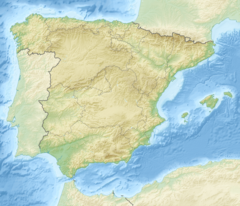Axlor facts for kids
| Location | Dima village |
|---|---|
| Region | Biscay, Basque Community |
| Coordinates | 43°07′16″N 2°43′41″W / 43.12111°N 2.72806°W |
| Type | rock shelter |
| History | |
| Material | Karst |
| Site notes | |
| Excavation dates | 1967, 2000 |
| Archaeologists | Jose Miguel Barandiaran |
Axlor is an amazing prehistoric place in the village of Dima, located in the Basque Community of Spain. It's a special site because it helps us learn about people who lived a very long time ago. This site dates back to the Middle Paleolithic period, also known as the Mousterian period. This was a time when Neanderthals walked the Earth!
Contents
Discovering Axlor: A Look at the Excavations
Axlor is a rock shelter, which means it's like the mouth of an old cave. Over time, this cave entrance filled up with clay.
First Discoveries by Jose Miguel Barandiaran
The famous archaeologist Jose Miguel Barandiaran found this site. He led the first digs from 1967 to 1974. His team found nine different layers of earth at Axlor. Five of these layers contained amazing stone tools made by Neanderthals.
- Jose Maria Basabe studied five teeth from a young Neanderthal found here.
- Jesus Altuna looked at the animal bones to see what creatures lived nearby.
- Later, A. Baldeón carefully studied the stone tools themselves.
New Digs and Modern Science
New excavations at Axlor started in 2000 and continued until 2009. These digs were led by J. González Urquijo and J. Ibañez Estévez. The new teams kept studying the stone tools and animal remains. They also looked at human bones.
But they added new ways to learn about the past:
- They studied tiny animal fossils, like those from rodents.
- They explored the geology of the area, especially the "Indusi karst" (a type of rocky landscape).
- They learned about the different layers of rock and soil.
- They used palynology, which is the study of pollen, to understand ancient plants.
- They used carpology, which is the study of other plant remains.
Life at Axlor: The Neanderthal Story
Axlor has many layers from the Middle Paleolithic period. These layers show us the later times of the Mousterian culture in the Pyrenees mountains. The newest layers at Axlor are about 42,000 years old. Scientists figure this out using a method called C14 radiocarbon analysis. Axlor is one of the few sites in the Basque region with such clear dates.
Smart Neanderthals and Their Tools
The Neanderthals who lived at Axlor were very clever. They planned ahead to use their environment. Their ways of life changed over time. This helps archaeologists piece together a "history" of these ancient people. These discoveries are changing the old idea that Neanderthals were not very smart.
The Neanderthals at Axlor made their stone tools from flint. This flint came from places far away, sometimes 30 to 60 kilometers from their home! They used different methods to work each type of stone. They chose the best method for its size, hardness, and how it broke.
Some of their tool-making techniques were quite complex. These included methods like Levallois, micro-Levallois, and Quina. These methods of working with flint and stone changed over time. They probably adapted to different traditions and the needs of the Neanderthals. They also changed based on what the environment offered.
Neanderthal Hunters
Archaeologists found spear-tips at Axlor with signs of use. This means they were likely used as hunting weapons. The Neanderthals from Axlor were excellent hunters. They hunted large and dangerous animals, like adult bovids (a type of wild cattle). Their smart planning also helped them manage hunting resources. They knew how to butcher animals and use all parts of them.
See also
 In Spanish: Axlor para niños
In Spanish: Axlor para niños


